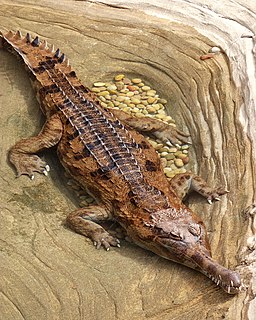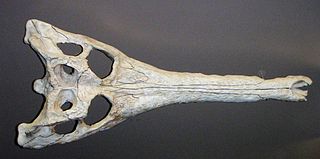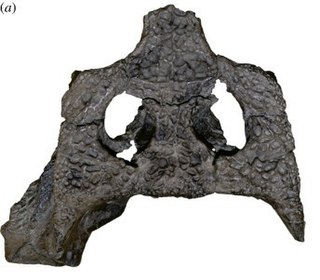
Gavialinae is a subfamily of large semiaquatic crocodilian reptiles, resembling crocodiles, but with much thinner snouts. Gavialinae is one of the two major subfamilies within the family Gavialidae - the other being the subfamily Tomistominae, which contains the false gharial and extinct relatives.

Melanosuchus is a genus of alligatorid caiman. The black caiman of South America is the sole extant (living) species, and is the largest living member of the subfamily caimaninae, and the entire alligator family.

Tomistoma is a genus of gavialid crocodilians. They are noted for their long narrow snouts used to catch fish, similar to the gharial. Tomistoma contains one extant (living) member, the False gharial, as well as potentially several extinct species: T. cairense, T. lusitanicum, T. taiwanicus, T. coppensi, and T. dowsoni. However, these species may need to be reclassified to different genera as studies have shown them to be paraphyletic.
Australosuchus is an extinct monospecific genus of crocodylian belonging to the subfamily Mekosuchinae. The type and only known species Australosuchus clarkae lived during the Late Oligocene and the Early Miocene of southern Australia. The generic name Australosuchus means "Southern crocodile". It was described in 1991 from fossil material discovered at Lake Palankarinna in South Australia.

Paleosuchus is a South American genus of reptiles in the subfamily Caimaninae of the family Alligatoridae. They are the smallest members of the order Crocodilia in the Americas. The genus contains two extant species and a yet unnamed fossil species.

Gavialosuchus is an extinct genus of gavialid crocodylian from the early Miocene of Europe. Currently only one species is recognized, as a few other species of Gavialosuchus have since been reclassified to other genera.
Eocaiman is an extinct genus of caiman containing species living from the Early Paleocene to Miocene in what is now Argentina, Itaboraí Formation of Brazil and Colombia. Eocaiman contains three described species: E. cavernensis, E. palaeocenicus, and E. itaboraiensis, and is typically recovered as one of the more basal members of Caimaninae. Notocaiman was synonymized with Eocaiman paleocenicus in 2022.
Dollosuchoides, colloquially known as the Crocodile of Maransart, is an extinct monospecific genus of gavialoid crocodilian, traditionally regarded as a member of the subfamily Tomistominae. Fossils have been found in the Brussel Formation of Maransart, Belgium and date back to the middle Eocene.

Gryposuchus is an extinct genus of gavialid crocodilian. Fossils have been found from Argentina, Colombia, Venezuela, Brazil and the Peruvian Amazon. The genus existed during the Miocene epoch. One recently described species, G. croizati, grew to an estimated length of 10 metres (33 ft). Gryposuchus is the type genus of the subfamily Gryposuchinae, although a 2018 study indicates that Gryposuchinae and Gryposuchus might be paraphyletic and rather an evolutionary grade towards the gharial.
Ikanogavialis is an extinct genus of gavialid crocodilian. Fossils have been found in the Urumaco Formation in Urumaco, Venezuela and the Solimões Formation of Brazil. The strata from which remains are found are late Miocene in age, rather than Pliocene as was once thought. A possible member of this genus survived into the Late Holocene on Muyua or Woodlark Island in Papua New Guinea.
Maroccosuchus zennaroi is an extinct gavialoid crocodylian from the Early Eocene of Morocco, traditionally regarded as a member of the subfamily Tomistominae.
Paratomistoma is an extinct monospecific genus of gavialoid crocodylian. It is based on the holotype specimen CGM 42188, a partial posterior skull and lower jaw discovered at Wadi Hitan, Egypt, in Middle Eocene-age rocks of the Gehannam Formation. The skull is unfused but considered morphologically mature. Paratomistoma was named in 2000 by Christopher Brochu and Philip Gingerich; the type species is P. courti in honor of Nicholas Court, who found CGM 42188. They performed a phylogenetic analysis and found Paratomistoma to be a derived member of Tomistominae, related to the false gharial. It may have been a marine or coastal crocodilian.

Piscogavialis is an extinct monospecific genus of gryposuchine gavialid crocodylian. The only species yet known is P. jugaliperforatus. Fossils of Piscogavialis have been found from the Mio-Pliocene Pisco Formation of the Sacaco Basin in southern Peru in 1998, where it coexisted with the much smaller gavialid Sacacosuchus.
Siquisiquesuchus is an extinct genus of gavialid crocodilian. It is known from cranial remains and a few postcranial bones found in Miocene-age rocks of the Castillo Formation in northwestern Venezuela.

Penghusuchus is an extinct genus of gavialid crocodylian. It is known from a skeleton found in Upper Miocene rocks of Penghu Island, off Taiwan. It may be related to two other fossil Asian gavialids: Maomingosuchus petrolica of southeastern China and Toyotamaphimeia machikanensis of Japan. The taxon was described in 2009 by Shan and colleagues; the type species is P. pani.
Gryposuchinae is an extinct subfamily of gavialid crocodylians. Gryposuchines lived mainly in the Miocene of South America. However, "Ikanogavialis" papuensis may have survived more recently, into the Late Pleistocene/Holocene. Most were long-snouted coastal forms. The group was named in 2007 and includes genera such as Gryposuchus and Aktiogavialis, although a 2018 study indicates that the group might be paraphyletic and rather an evolutionary grade towards the gharial.

Gavialis browni is an extinct species of the crocodylian genus Gavialis and a close relative of the living gharial Gavialis gangeticus.
Tomistoma cairense is an extinct species of gavialoid crocodilian from the Lutetian stage of the Eocene era. It lived in North East Africa, especially Egypt. Remains of T. cairense have been found in the Mokattam Formation, in Mokattam, Egypt. Tomistoma cairense did not have a Maxilla process within their lacrimal gland, whereas all extant (living) crocodilians do.

Protocaiman is a caimanine genus of crocodylian first described in 2018. The type species Protocaiman peligrensis was discovered in Argentina's Salamanca Formation, and lived in Patagonia during the Paleocene era.
Portugalosuchus is an extinct genus of eusuchian crocodyliform that was possibly a basal crocodylian – if so then it would be the oldest known crocodylian to date. The type species is P. azenhae, described in 2018, and it is known from the Late Cretaceous (Cenomanian)-aged Tentugal Formation in Portugal. A 2021 morphological study recovered Portugalosuchus within Crocodylia as a member of Gavialidae closely related to similar "thoracosaurs", while also noting that is might also possibly be outside of Crocodylia completely. A 2022 tip dating analysis incorporating both morphological and DNA data placed Portugalosuchus outside of Crocodylia, as the sister taxon of the family Allodaposuchidae. A cladogram simplified after that analysis is shown below:












